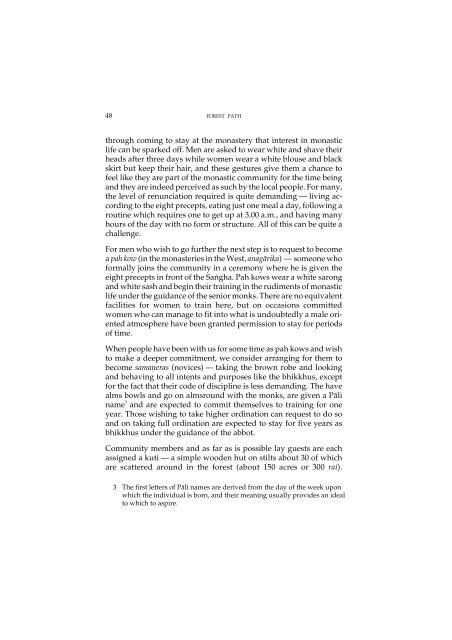Forest Path - Amaravati Buddhist Monastery
Forest Path - Amaravati Buddhist Monastery
Forest Path - Amaravati Buddhist Monastery
You also want an ePaper? Increase the reach of your titles
YUMPU automatically turns print PDFs into web optimized ePapers that Google loves.
48 forest path<br />
through coming to stay at the monastery that interest in monastic<br />
life can be sparked off. Men are asked to wear white and shave their<br />
heads after three days while women wear a white blouse and black<br />
skirt but keep their hair, and these gestures give them a chance to<br />
feel like they are part of the monastic community for the time being<br />
and they are indeed perceived as such by the local people. For many,<br />
the level of renunciation required is quite demanding — living according<br />
to the eight precepts, eating just one meal a day, following a<br />
routine which requires one to get up at 3.00 a.m., and having many<br />
hours of the day with no form or structure. All of this can be quite a<br />
challenge.<br />
For men who wish to go further the next step is to request to become<br />
a pah kow (in the monasteries in the West, anagàrika) — someone who<br />
formally joins the community in a ceremony where he is given the<br />
eight precepts in front of the Saïgha. Pah kows wear a white sarong<br />
and white sash and begin their training in the rudiments of monastic<br />
life under the guidance of the senior monks. There are no equivalent<br />
facilities for women to train here, but on occasions committed<br />
women who can manage to fit into what is undoubtedly a male oriented<br />
atmosphere have been granted permission to stay for periods<br />
of time.<br />
When people have been with us for some time as pah kows and wish<br />
to make a deeper commitment, we consider arranging for them to<br />
become samaõeras (novices) — taking the brown robe and looking<br />
and behaving to all intents and purposes like the bhikkhus, except<br />
for the fact that their code of discipline is less demanding. The have<br />
alms bowls and go on almsround with the monks, are given a Pàli<br />
name 3 and are expected to commit themselves to training for one<br />
year. Those wishing to take higher ordination can request to do so<br />
and on taking full ordination are expected to stay for five years as<br />
bhikkhus under the guidance of the abbot.<br />
Community members and as far as is possible lay guests are each<br />
assigned a kuti — a simple wooden hut on stilts about 30 of which<br />
are scattered around in the forest (about 150 acres or 300 rai).<br />
3 The first letters of Pàli names are derived from the day of the week upon<br />
which the individual is born, and their meaning usually provides an ideal<br />
to which to aspire.

















